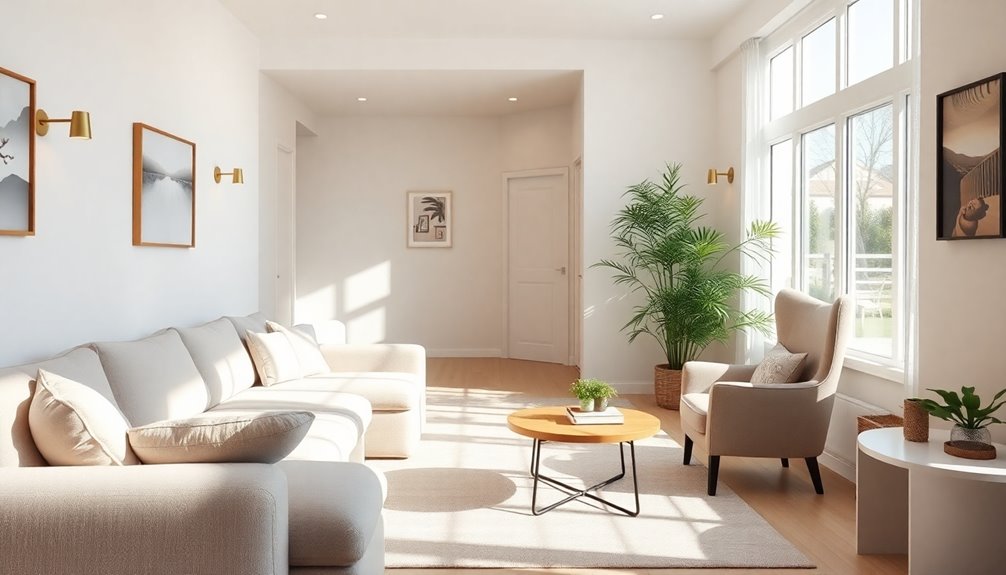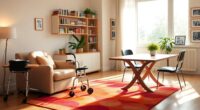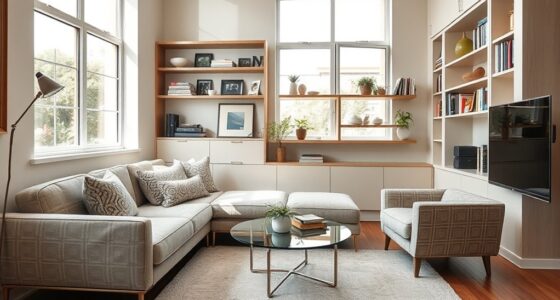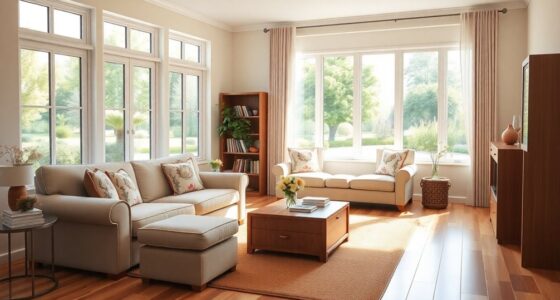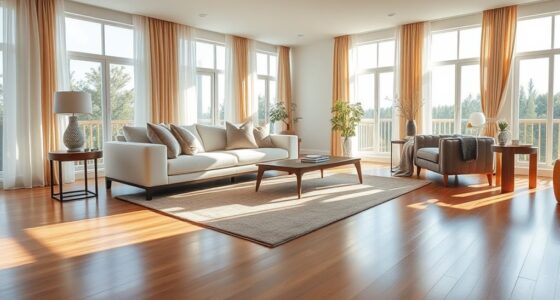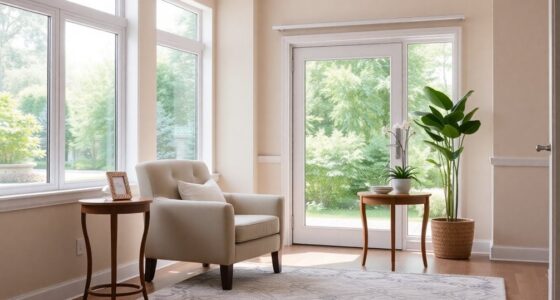To create a home that's perfect for aging in place, focus on open layouts that enhance mobility and incorporate non-slip flooring solutions. Guarantee adequate lighting to prevent falls, and design accessible kitchens with adjustable countertops and roll-under sinks. Make bathroom safety a priority with grab bars and non-slip mats. Bedroom modifications like electric adjustable beds can enhance comfort. Don't forget entry access improvements and smart technology for added security. Stick around to discover even more practical tips!
Key Takeaways
- Create open layouts with clear pathways and flexible furniture arrangements to enhance mobility and independence for seniors.
- Install grab bars in bathrooms and use non-slip flooring materials to significantly reduce fall risks throughout the home.
- Ensure adequate lighting with indirect fixtures and automated systems to improve visibility and safety in all areas.
- Incorporate accessible kitchen features like adjustable-height countertops and lever handles to facilitate easier meal preparation.
- Design no-step entrances and wide doorways for seamless access, while adding smart technology for enhanced convenience and safety.
Open Layouts for Enhanced Mobility
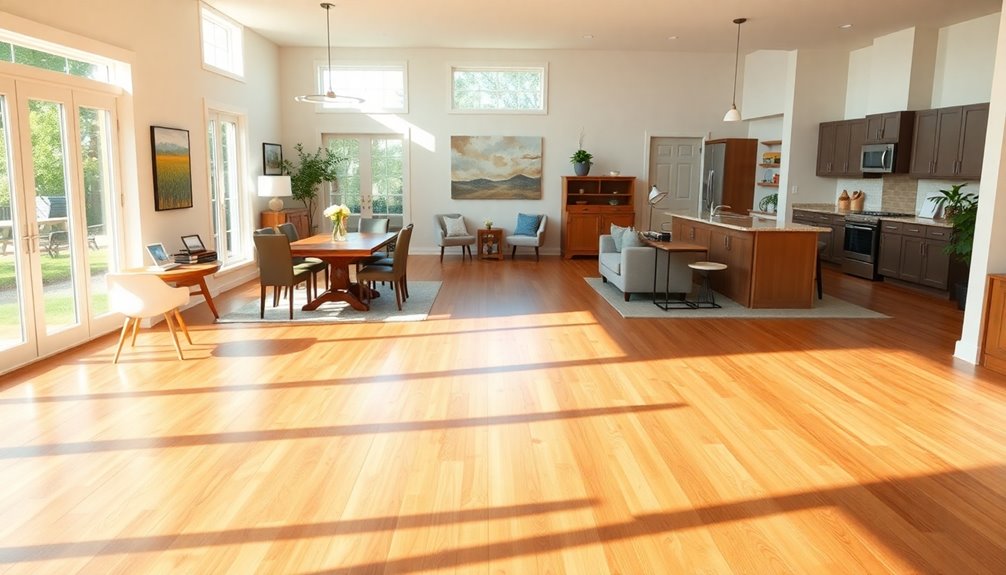
Open layouts minimize obstacles, allowing seniors to navigate their spaces with ease, whether they use walkers or wheelchairs. By removing walls, you enhance visibility, making it easier for caregivers to monitor movement.
A clutter-free environment reduces fall risks, promoting a safe and comfortable atmosphere. Wider doorways and unobstructed pathways are essential for accommodating varying mobility needs, ensuring that everyone can move freely.
Additionally, incorporating adaptable living areas with flexible furniture arrangements allows your home to evolve as individuals age, continuously supporting their independence and comfort. Prioritizing open floor plans in mind transforms your space into a haven for all.
Non-Slip Flooring Solutions
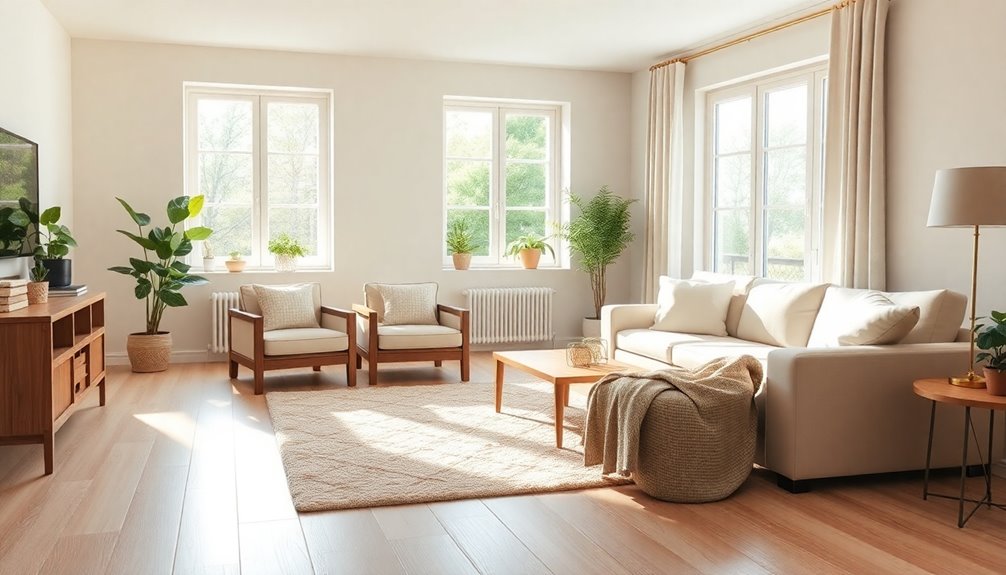
When choosing flooring for aging in place, consider non-slip materials like cork, rubber, or linoleum to enhance safety. You'll want to integrate safety features like contrasting colors to signal changes in elevation and avoid shiny surfaces that can confuse depth perception. Regular maintenance, including securing area rugs with non-slip pads, guarantees your home remains a safe environment. Additionally, choose flooring options that promote natural elements to create a calming atmosphere conducive to relaxation and comfort.
Flooring Material Recommendations
Choosing the right flooring is essential for creating a safe environment for seniors aging in place. Opt for non-slip surfaces like cork, rubber, or linoleum, as these materials enhance safety and accessibility by reducing slip hazards.
Smooth and level flooring minimizes trip hazards, allowing for easier mobility. Avoid shiny surfaces and busy patterns, which can impair depth perception and increase fall risks for those with visual impairments.
Incorporate contrasting colors or textures at thresholds to provide visual cues that help navigate different areas. Additionally, using non-glare finishes will improve visibility, further supporting safe movement within the home.
Furthermore, ensuring proper insulation upgrades can also contribute to a more comfortable temperature within the home, making it easier for seniors to navigate their space effectively.
With these considerations, you can create a comfortable and secure space for your loved ones.
Safety Features Integration
Integrating safety features into your home's flooring is essential for ensuring a secure environment as you age in place. Opt for durable materials like cork and rubber, which provide excellent traction to prevent falls. Textured flooring can enhance grip, especially in moisture-prone areas like kitchens and bathrooms. Additionally, consider using non-slip mats in high-traffic zones to reduce slipping risks and improve comfort. Change strips with contrasting colors help signal changes in flooring type or level, alerting you to potential trip hazards. Furthermore, maintaining indoor air quality through proper ventilation and air purification can further enhance safety and comfort in your living environment.
| Flooring Type | Benefits | Recommended Areas |
|---|---|---|
| Cork | Durable, non-slip | Living rooms, bedrooms |
| Rubber | Traction, easy to clean | Kitchens, bathrooms |
| Textured Vinyl | Grip and stability | Entryways, hallways |
Maintenance and Care Tips
To keep your non-slip flooring solutions effective, regular maintenance is key.
Choose non-slip flooring options like cork, rubber, or textured vinyl that minimize slips and falls.
Make certain to install non-slip mats in high-risk areas like kitchens and bathrooms for added traction.
It's essential to guarantee that all changes between different flooring types are smooth and level to prevent trip hazards.
Regularly address spills immediately, and secure any rugs with non-slip pads to maintain safety.
Opt for flooring finishes with a matte surface, as they improve visibility and help seniors gauge depth perception, reducing the likelihood of falls. Additionally, ensuring air quality through the use of air purifiers can further enhance the safety and comfort of living spaces for seniors.
Adequate Lighting for Safety
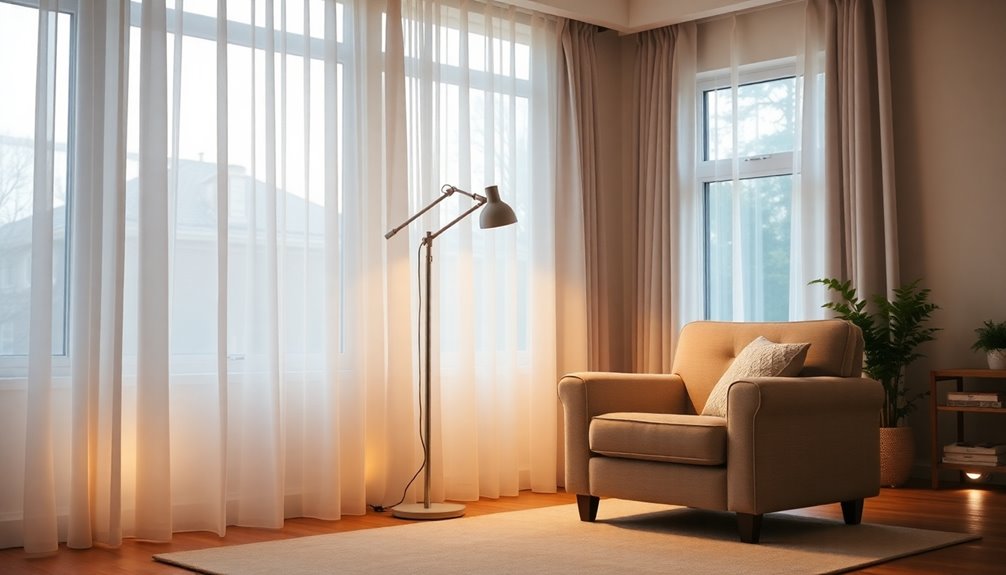
Adequate lighting plays an essential role in ensuring safety for older adults at home. By enhancing visibility, you can considerably reduce the risk of accidents.
Here are some tips to improve your lighting setup:
- Use indirect lighting: This reduces glare and shadows, minimizing trip hazards as you navigate your home.
- Install LED fixtures: They last longer and require less frequent bulb changes, easing maintenance efforts.
- Position electrical outlets: Keep them 18 to 24 inches off the ground, allowing seniors to easily access power sources without bending.
For ideal lighting, aim for a color temperature between 2,700 and 3,000 Kelvin with a CRI of 100 to enhance visibility and color distinction. Additionally, consider using air purifiers to improve indoor air quality as they can help create a healthier environment for aging individuals.
Prioritize these changes for a safer living space!
Accessible Kitchen Design
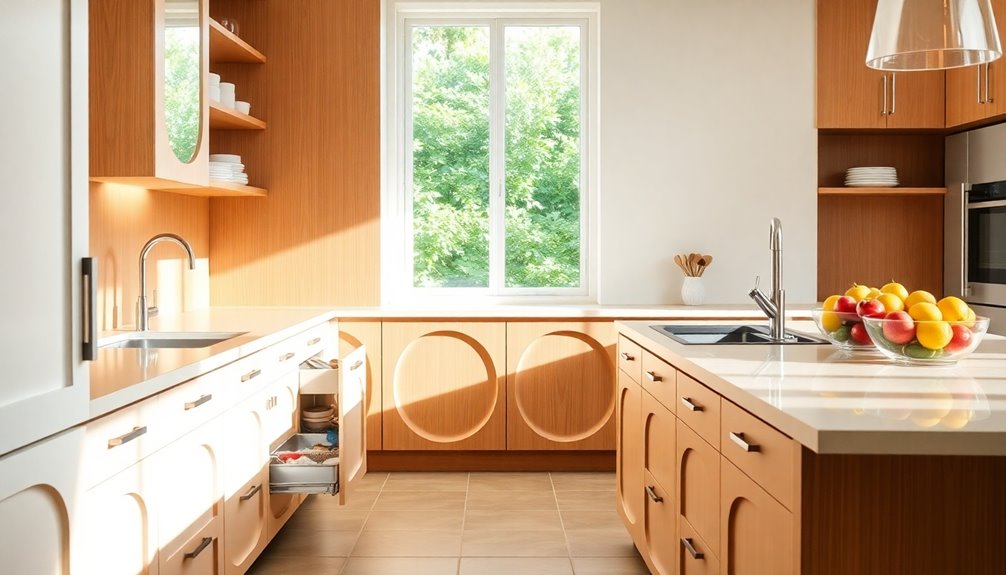
An accessible kitchen design transforms meal preparation into an enjoyable and manageable task for older adults. By incorporating features like adjustable-height countertops and roll-under sinks, you promote independence and comfort in the kitchen.
Lever handles on cabinets and appliances make them easier to operate, enhancing usability. Improved lighting, such as under-cabinet fixtures and motion-sensor lights, guarantees safety by illuminating cooking areas effectively.
To reduce fatigue, consider non-slip anti-fatigue mats near sinks and cooking zones, providing support during prolonged standing. Sturdy stools or chairs can offer a place to rest while you cook, contributing to comfortable living.
Collaborating with an Aging in Place Specialist can help tailor these elements to your specific needs, guaranteeing your kitchen remains functional and inviting.
Safe and Comfortable Bathroom Features
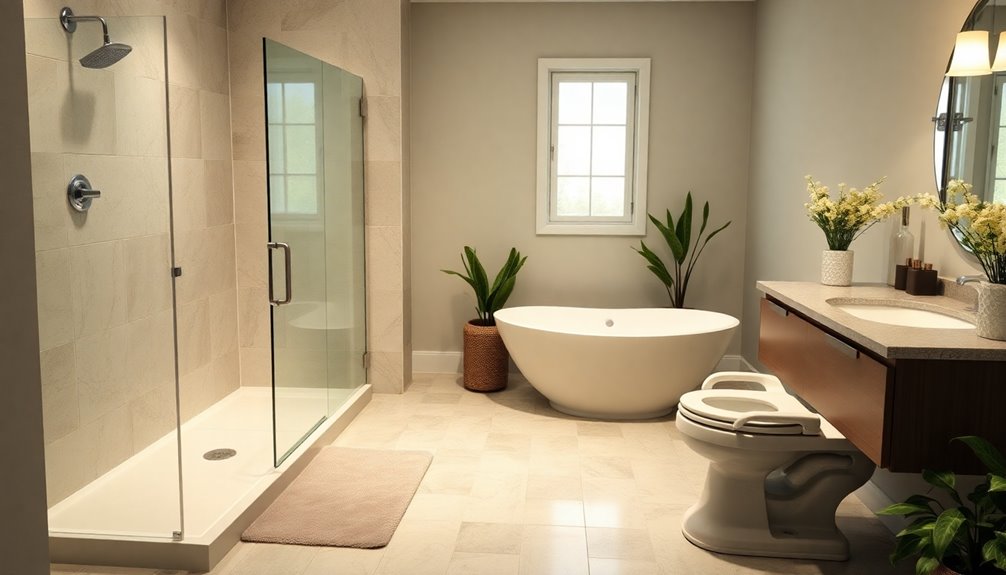
When designing a safe and comfortable bathroom, consider a walk-in shower to eliminate the risk of stepping over a tub.
Installing grab bars can provide essential support, making it easier and safer to navigate during bathing.
These changes not only enhance safety but also promote independence and confidence in your daily routine. Additionally, integrating heat pump technology can help maintain a comfortable temperature year-round, contributing to an overall pleasant environment.
Walk-In Shower Design
To create a safe and comfortable bathroom, consider the benefits of a walk-in shower, which eliminates the need to step over bathtubs and greatly reduces the risk of falls.
This design enhances accessibility and safety for everyone, especially seniors.
Here are three key features to include:
- Curbless Design: This allows for seamless entry and exit, making it easier for wheelchair users or those with mobility aids.
- Non-Slip Flooring: Incorporating textured tiles and non-slip surfaces prevents slips, ensuring confidence during use.
- Handheld Showerhead: An adjustable handheld showerhead promotes independence, allowing you to bathe comfortably without assistance.
Additionally, installing energy-efficient heat pumps can enhance overall comfort in your home by maintaining consistent indoor temperatures while reducing energy costs.
Grab Bars Installation
Installing grab bars in your bathroom can make a considerable difference in safety and comfort, especially for seniors.
These essential features greatly reduce the risk of falls by offering support when entering or exiting showers, tubs, and toilets. Verify your grab bars are securely anchored to wall studs and installed at heights between 33 to 36 inches for peak accessibility.
Choose stylish grab bars that complement your bathroom decor, so they blend seamlessly into the space without appearing institutional. Look for options with non-slip finishes, providing a secure grip even when hands are wet.
Place grab bars in strategic locations, like alongside toilets and inside showers, to offer the assistance needed during daily routines. Additionally, maintaining good air quality considerations in your home can further enhance safety and comfort for seniors.
Clutter-Free Living Room Arrangements
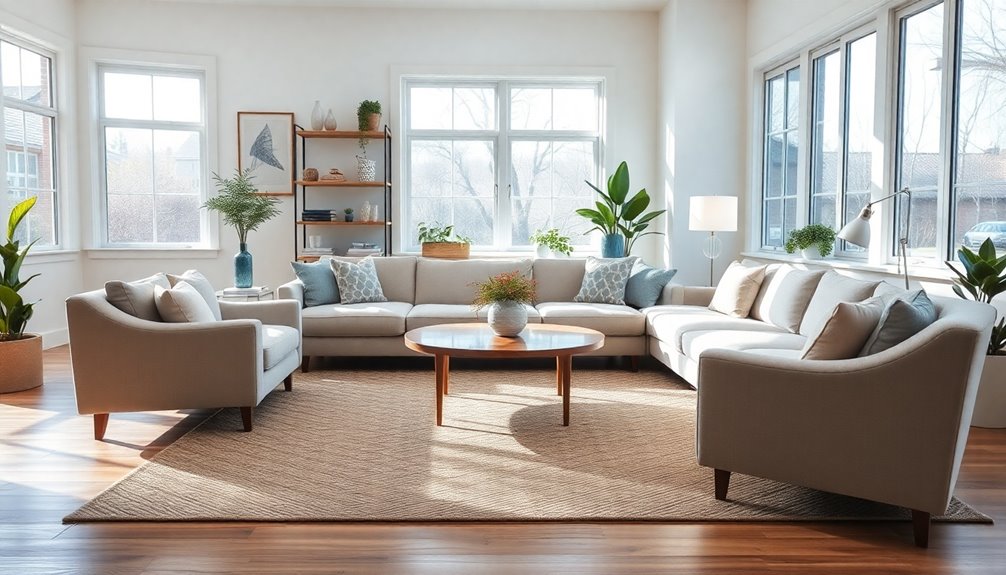
Creating a clutter-free living room not only enhances the aesthetic appeal of your space but also promotes safety and mobility for seniors. To achieve this, consider the following tips:
- Clear Pathways: Arrange furniture to allow clear pathways of at least 36 inches. This guarantees accessibility for walkers and wheelchairs, reducing fall risks and promoting balance.
- Lightweight Furniture: Use lightweight, movable furniture that can easily be reconfigured for various activities, making your space adaptable to different needs.
- Effective Storage Solutions: Incorporate storage solutions like baskets or built-in shelves to keep frequently used items within reach while minimizing clutter.
Additionally, maintain well-lit areas with indirect lighting to reduce shadows and glare, further enhancing safety in your clutter-free living space. A clean home also reduces allergens and pollutants, which can significantly benefit seniors' health and comfort.
Bedroom Modifications for Comfort
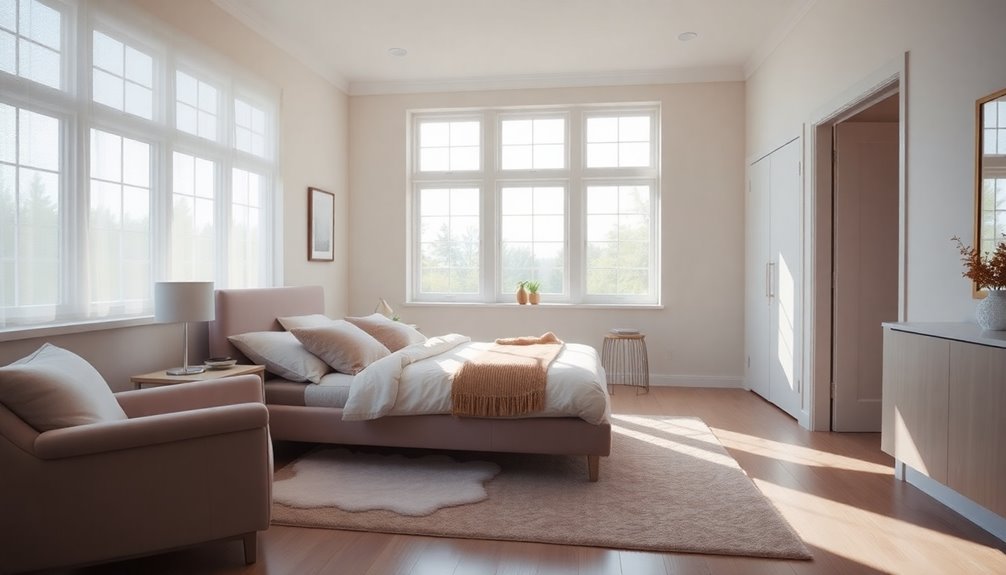
A clutter-free living room sets the stage for a safe and welcoming home, but the bedroom is where comfort truly matters for aging in place. To enhance comfort and accessibility for seniors, consider these modifications:
| Modification | Benefit | Considerations |
|---|---|---|
| Soft, plush carpet | Enhances joint comfort and warmth | Prevents trip hazards |
| Closet organizers | Reduces clutter and improves access | Keeps essentials handy |
| Sturdy chairs in closets | Provides a resting spot | Aids in dressing |
| Electric adjustable beds | Facilitates safe shifts | Customizes sleeping position |
| Stair lifts in homes | Improves multi-level accessibility | Reduces fall risk |
Entry Access Improvements

When enhancing entry access for seniors, ensuring a seamless shift into the home is essential for safety and comfort. Here are some important entry access improvements you can make:
- No-step entrance: Aim for a flat, sheltered landing that accommodates wheelchairs or walkers.
- Wide doors with lever handles: Install doors at least 36 inches wide to facilitate the use of mobility aids.
- Flush thresholds: Create minimal height differences to eliminate tripping hazards.
Additionally, consider incorporating benches near entryways for easier footwear changes and secure rugs with non-slip pads.
Maintaining clear aisles throughout your home will prevent falls and enhance navigation, making your entryway both accessible and inviting.
Smart Technology Integration
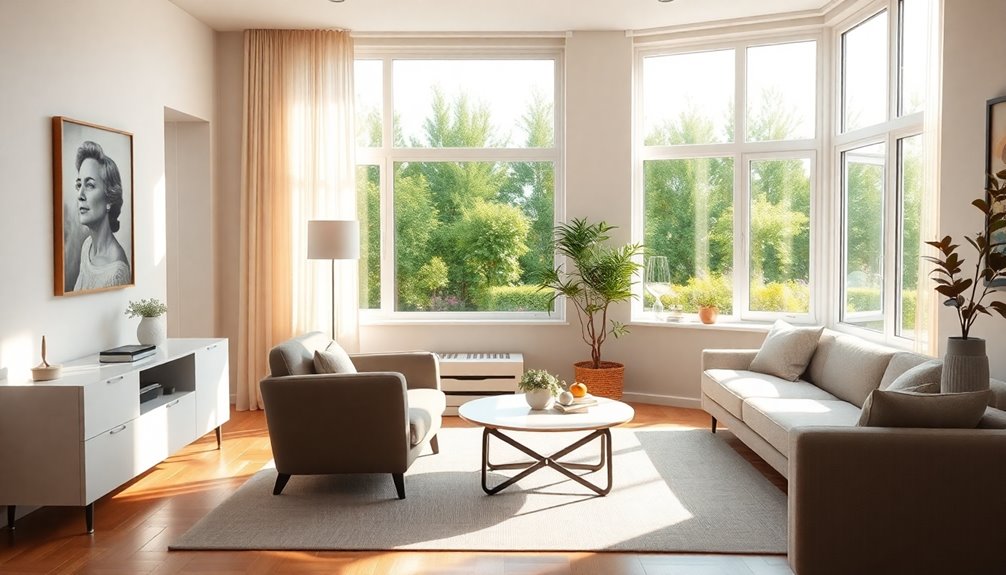
Integrating smart technology into your home can greatly enhance comfort and safety for aging in place.
With smart technology integration, you can control lighting, temperature, and security effortlessly using your smartphone or tablet, reducing physical strain.
Voice-activated assistants can assist you with daily tasks like setting reminders or making calls, promoting your independence and ease of use.
Motion sensors can alert caregivers to inactivity, ensuring timely assistance and enhancing security.
Additionally, connected devices such as smart locks and security cameras allow you to manage home access remotely, providing peace of mind.
Future-Proofing Your Home Design

Smart technology not only enhances comfort and safety but also plays an essential role in future-proofing your home design.
To create accessible living spaces that accommodate aging, consider these key elements:
- Flexible Design: Plan for wide passageways (at least 36 inches) and rough plumbing for potential bathroom additions.
- Smart Features: Incorporate voice-activated assistants and automated lighting to promote independence and enhance safety.
- Seamless Changes: Guarantee connectors between old and new areas are designed thoughtfully, possibly adding elevators or stair lifts.
Frequently Asked Questions
What Is the Best Home Design for Aging in Place?
The best home design for aging in place focuses on safety and accessibility.
You'll want to eliminate trip hazards and install non-slip flooring to prevent falls.
Make sure your entryways are accessible with no-step entrances and wide doorways.
Incorporate universal design elements like lever door handles and rocker light switches.
In kitchens and bathrooms, adjustable counter heights and walk-in showers can enhance your independence and comfort, creating a more accommodating living space.
How to Design for Aging in Place?
To design for aging in place, you'll want to prioritize accessibility and safety.
Start by ensuring no-step entrances and wide doorways for easy access. Choose soft flooring to reduce the risk of falls, and consider adjustable counter heights for convenience.
In the bathroom, install features like walk-in showers and grab bars.
Finally, incorporate smart home technology to simplify daily tasks and enhance security, making your home both functional and comfortable.
How Do I Prepare My House to Age in Place?
Did you know that nearly 90% of seniors prefer to stay in their homes as they age?
To prepare your house for aging in place, start by ensuring a no-step entrance and wide doorways.
Clear pathways and non-slip flooring reduce fall risks.
In the kitchen, adjustable counters and pull-out shelves can enhance safety.
Don't forget to update bathrooms with grab bars and raised toilet seats, making daily tasks easier and safer for you.
What Is Aging in Place in Interior Design?
Aging in place in interior design means creating a home environment that lets you live independently and safely as you grow older. This approach incorporates features such as wider doorways, non-slip flooring, and strategically placed lighting to reduce hazards and enhance mobility. Additionally, interior design for aging in place often includes accessible bathrooms and kitchens, cleverly designed storage solutions, and technology integration for convenience and safety. By prioritizing comfort and accessibility, homeowners can enjoy their living spaces without the need for constant modifications or relocations.
It focuses on safety, accessibility, and comfort, ensuring your space adapts to your changing needs.
Key features include wide doorways, non-slip flooring, and easily reachable storage.
Conclusion
By weaving these design tricks into your home, you're crafting a sanctuary that dances with accessibility and comfort. Each room becomes a welcoming embrace, ensuring you can move freely and safely as time flows on. With thoughtful touches like non-slip floors and smart technology, your space transforms into a harmonious haven, where aging gracefully is not just a possibility, but a reality. So, let your home reflect the beauty of your journey, every step of the way.
